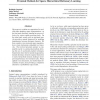Free Online Productivity Tools
i2Speak
i2Symbol
i2OCR
iTex2Img
iWeb2Print
iWeb2Shot
i2Type
iPdf2Split
iPdf2Merge
i2Bopomofo
i2Arabic
i2Style
i2Image
i2PDF
iLatex2Rtf
Sci2ools
ICML
2010
IEEE
2010
IEEE
Proximal Methods for Sparse Hierarchical Dictionary Learning
We propose to combine two approaches for modeling data admitting sparse representations: on the one hand, dictionary learning has proven effective for various signal processing tasks. On the other hand, recent work on structured sparsity provides a natural framework for modeling dependencies between dictionary elements. We thus consider a tree-structured sparse regularization to learn dictionaries embedded in a hierarchy. The involved proximal operator is computable exactly via a primal-dual method, allowing the use of accelerated gradient techniques. Experiments show that for natural image patches, learned dictionary elements organize themselves in such a hierarchical structure, leading to an improved performance for restoration tasks. When applied to text documents, our method learns hierarchies of topics, thus providing a competitive alternative to probabilistic topic models.
Dictionary Elements | ICML 2010 | Machine Learning | Signal Processing Tasks | Tree-structured Sparse Regularization |
Related Content
| Added | 09 Nov 2010 |
| Updated | 09 Nov 2010 |
| Type | Conference |
| Year | 2010 |
| Where | ICML |
| Authors | Rodolphe Jenatton, Julien Mairal, Guillaume Obozinski, Francis Bach |
Comments (0)

